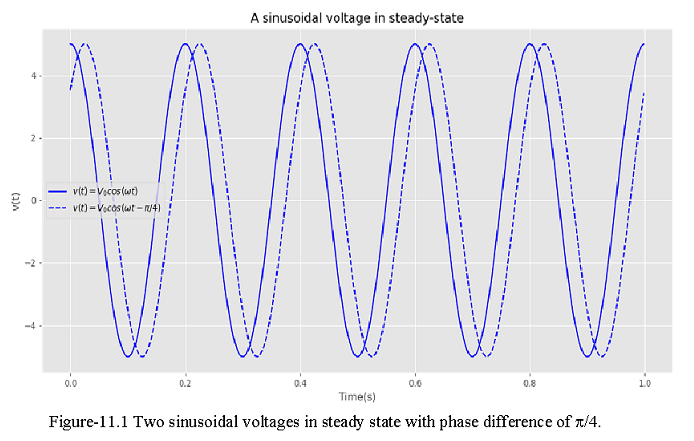Lab-11 Steady State Sinusoidal Analysis:
Learning Objectives:
Name: Write down your name
Date: Date of report submission and date of lab performed
The term “Sinusoidal Steady-State” refers to how ac circuits are modeled once the transient has passed. Any periodic waveform can be represented by a repetitive sinusoidal waveforms, therefore studying a single sinusoidal waveform can make subsequent analysis easier.
It is important to have steady-state conditions, because it is the steady-state that determines continuous ratings of the equipment.
In ac systems the steady-state voltages and currents are modeled by sinusoidal waveforms.
Sinusoidal Sources:
An ac voltage is modeled as:
\[v(t) = V_0cos(\omega t + \theta)~~~~(11.1)\]
The plot of Eq. (11.1) is shown in Figure 11.1.

In Eq. (11.1), \(V_0\) is the peak or the maximum voltage.
\(\omega=2\pi f\) is the frequency in radians per second (rad/s).
f is the frequency in hertz (Hz), which are cycles per second, \(f=\frac{1}{T}\).
T is the periodic time of the oscillations, \(T=\frac{2\pi}{\omega}\)
\(\theta\) is the phase angle and allows for the fact that the waveform may not be zero or maximum when t = 0. The phase angle is shown in Figure 11.1 for a waveform represented by a cosine wave, since it is measured from the maximum. For a given frequency, \(\omega\) is constant and if all waveforms are represented as cosine waves then the only information that has to be conveyed from Eq. (11.1) is \(V_0\) and \(\theta\), which can be put into vector form as:
\(\bf V_0\) = \(V_0\angle\theta\). This vector form is known as a phasor.
Using the peak value to represent voltage (or current) does not seem reasonable since this value only exists for an infinitesimal time and using the average value is also not appropriate since it is zero. The appropriate value to use is one that gives the same power dissipation in a resistor in an ac circuit that would result if dc were applied. This dc equivalent quantity is the rms value, which for a sinusoid is obtained by dividing the peak value by \(\sqrt 2\). The rms values of voltage and current can be represented as:
\[V_{rms}=\frac{V_0}{\sqrt 2}~and~I_{rms}=\frac{I_0}{\sqrt 2}\] to be continued……